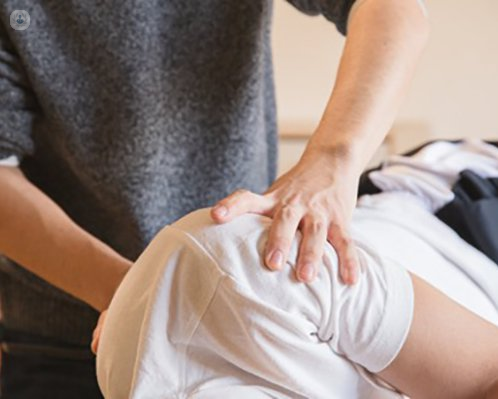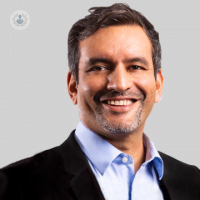Sports injuries of the shoulder or elbow: how long do they take to heal?
Written by:We spoke to consultant orthopaedic surgeon and the Medical Director of the Orthopaedic Specialists, Mr Ali Noorani about the commonest sports injuries of the upper limb and elbows that he treats in his clinic. In this article, he explains just how long injuries such as shoulder dislocations, tennis elbow and rotator cuff tears may take to heal, and how a specialist determines whether surgery is necessary or not in each case.

What are the most common sports injuries that you see?
I specialise as a shoulder and elbow surgeon. The commonest sports injuries of the upper limb that I treat include shoulder dislocations, where the shoulder feels unstable and is popping in and out, and tears of the rotator cuff.
Tennis elbow is one of the most common elbow problems that I treat. I also see patients who have had injuries from various sports, such as tennis and cycling or patients who play contact sports like boxing and rugby. They may have soft tissue injury or bone injuries, such as dislocation and fractures.
What upper limb sports injuries take the longest to heal?
Most patients that see me don’t actually require surgery and lots of people have injuries that can heal by themselves. The ones that need treatment are the ones that are completely displaced or who have injuries that are unstable.
Injuries happen all of the time but if ligaments, bones and tendons are injured, some patients will find that they are in a good position to heal naturally. Some may need biologics like an injection of platelet-rich plasma (PRP). Other patients with significant injuries (dislocation, popping in and out, torn tendons) are offered surgery.
Generally speaking, bones tend to heal slightly faster than soft tissue injuries. For example, patients with a typical collar bone fracture that needs plating, actually feel good, very quickly. As there is a plate holding all of the bits together, they feel confident and stable in such a short period of time.
The healing time takes longer but the bone will heal over the next two to four months. The patient may feel healed and back to function, but on X-rays, it takes longer to appear as healed. On the other hand, injuries of the rotator cuff can take a minimum of six months to a year to fully heal.
How do you help sports injuries to heal faster?
The first decision we make is whether the patient needs surgery or not. If patients have pain and poor function and are not improving and if tendons or ligaments are torn and retracted, surgery may be a good option.
We look at surgery as a very small step of the full picture. The way I describe it to my patients is that if you imagine you’re running a 100m race. Surgery is something that gets you off the blocks in the race and moves you for the first 10 metres. Then you need time and most importantly rehabilitation to get to the rest of the 90 metres to the finish line.
Good rehabilitation is essential and without it, recovery is slow and unpredictable. Surgery puts things in the right place anatomically for faster healing results.
We also provide supplements for patients, such as vitamin D, and recommend how they can improve their diet in order to heal better. On occasion, we use biologics and platelet-rich plasma (PRP) therapy or other derived cells to encourage faster healing.
What approaches do you take to avoid surgery where possible?
Even though I am a trained surgeon my patients come to see me for an opinion on what all the options are. It’s not necessarily just for surgery, which is usually the last resort in treatment. They come to me for an accurate diagnosis and the best way that we can manage their condition. My job is to make sure that the patient has the best possible outcome.
Every patient has very different needs. I see sports elite athletes who can’t afford time off and want something predictable, which needs to be done immediately. I may see the weekend warrior who may want to take a different approach and avoid surgery. Once we know what the problem is, we can decide whether someone is likely to do better with surgical or nonsurgical options.
Generally speaking, around 20% of patients end up having surgery and those who do, have it for a good reason. For example, someone might have a really terrible bone injury and fixing that will result in good outcomes, but not fixing it may generally mean a poorer outcome. There are some patients who never need surgery, such as those with bad posture because all they need is good rehabilitation for their muscles.
If surgery is necessary, how do you reduce recovery time?
Different conditions have different surgical outcomes. The most important thing with anyone having surgery is that they have a very clear view of what they are having done.
If someone requires surgery, I use different resources (visual aids, models and videos) to educate them on what to expect.
My patients’ expectations are usually met beforehand. I ask them for the specific things that they want out of surgery as everyone is different. Some want to be able to drive as soon as possible or to get back to doing their manual job.
It is very important to tailor their expectations and sometimes it is not possible to do it a certain way, but if we know their desires and use rehabilitation, we can make adjustments. The most successful outcomes depend on a lot of patient factors as some heal faster than others, so it really does depend on the individual case.
A typical fracture that we fix can feel good in a matter of days or weeks. Somebody with shoulder dislocation might take up to three months to feel a great benefit, whereas a patient with rotator cuff tear could take between six months to a year to heal.
If you would like to discuss any shoulder or elbow problems that you are experiencing with Mr Noorani, you can book an appointment with him via his Top Doctor’s profile here.


